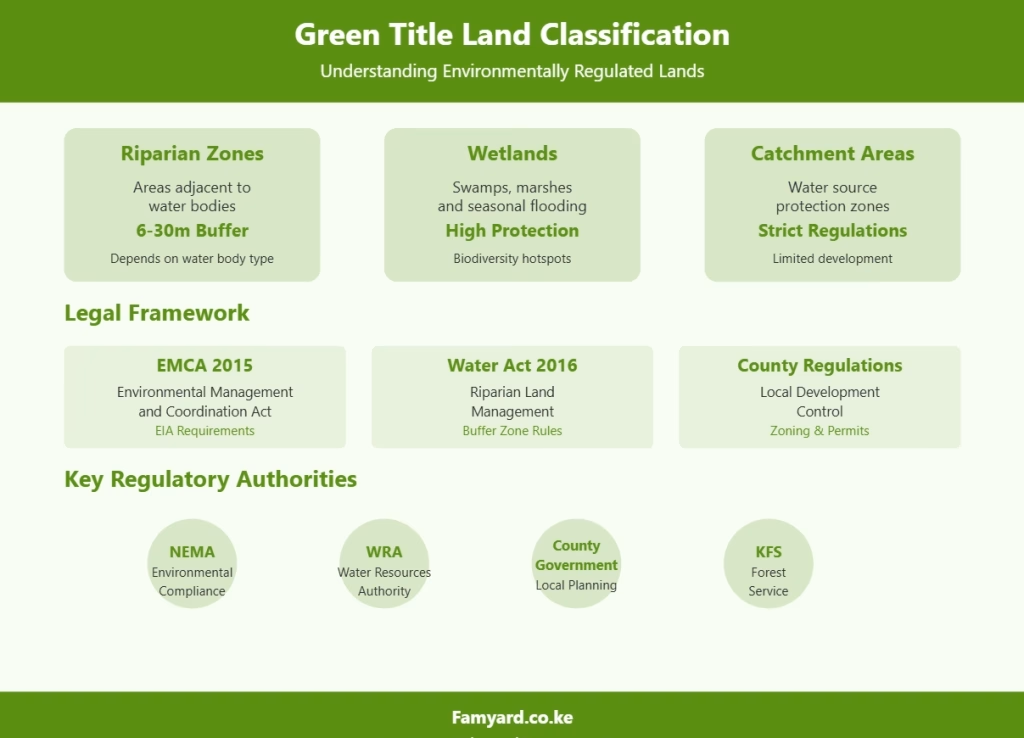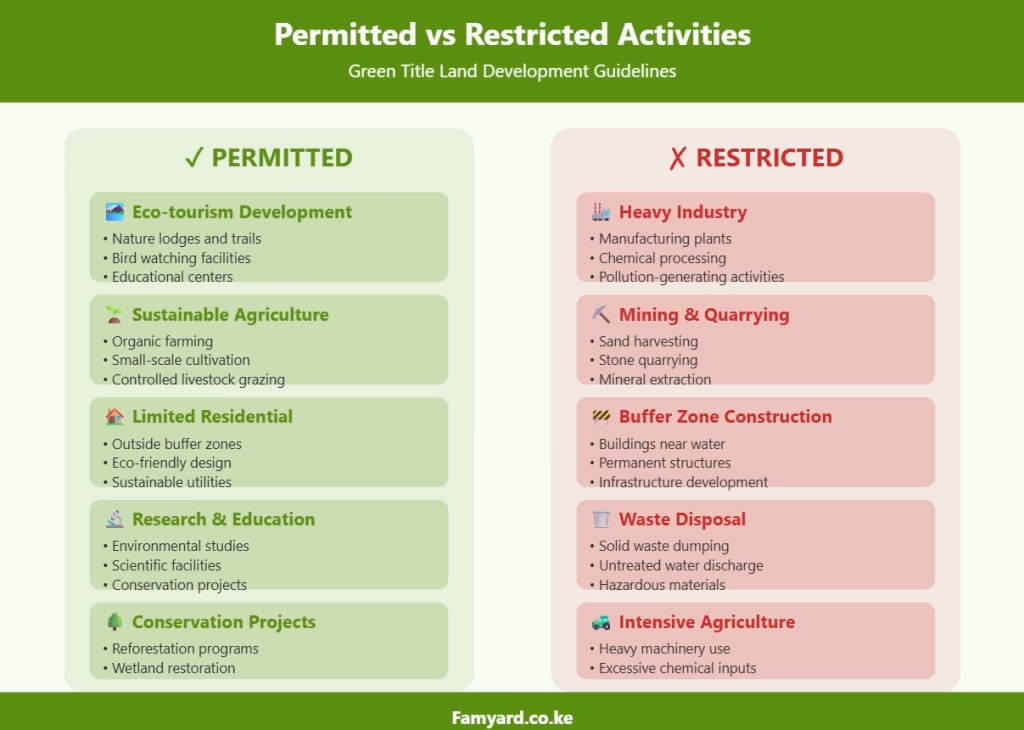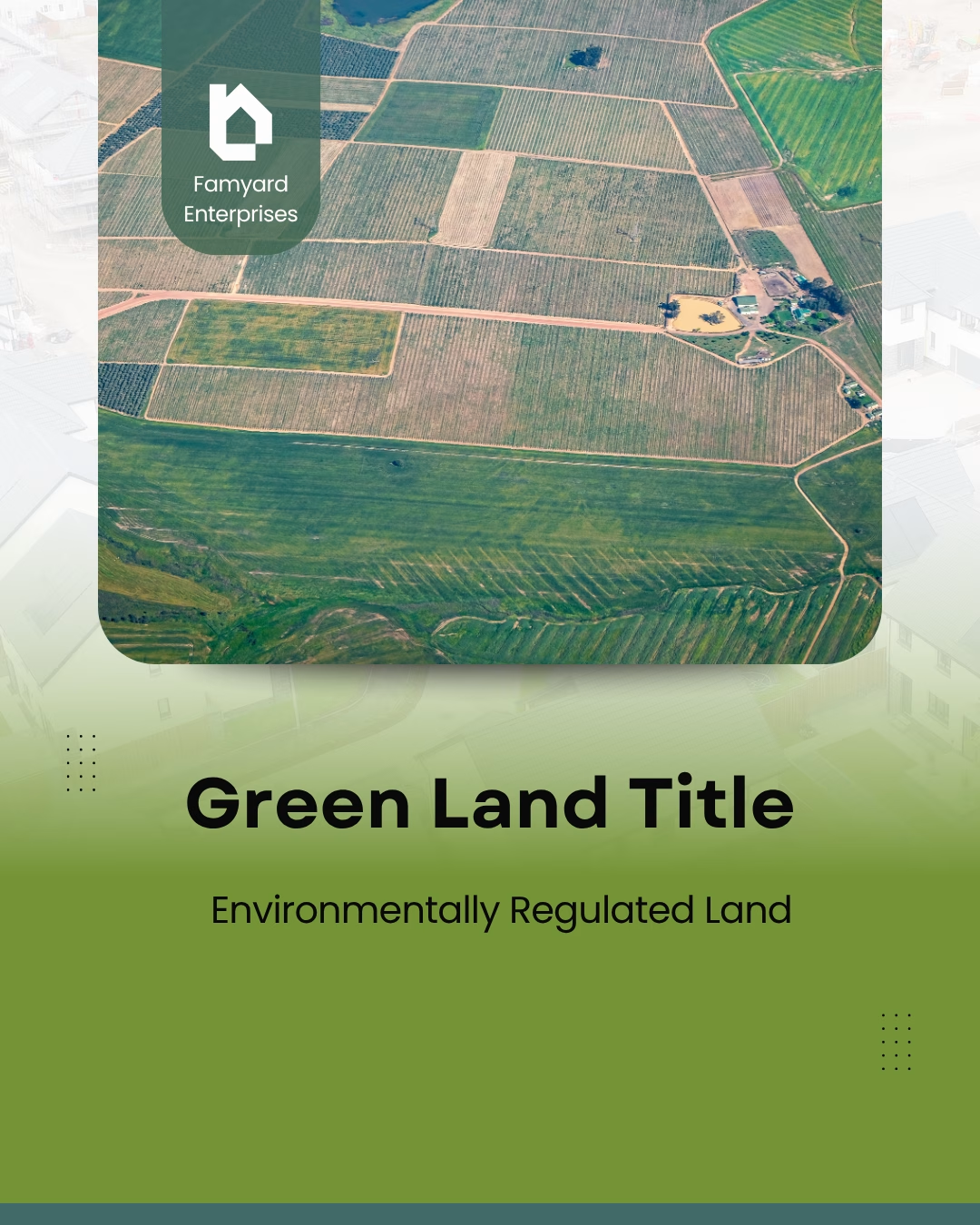Understanding land classifications in Kenya is crucial for any property investor or landowner. Among the various classifications, green title lands represent some of the most environmentally sensitive areas that require special attention and compliance with specific regulations. These lands, particularly riparian zones, come with unique opportunities and restrictions that every stakeholder should understand.
What Are Green Title Lands?
Green title lands refer to environmentally sensitive areas that have been designated for protection under Kenya’s environmental laws. These areas are primarily governed by the Environmental Management and Coordination Act (EMCA) 2015 and the Water Act 2016. The classification ensures that activities on these lands align with environmental conservation goals while allowing for sustainable development.
The most common type of green title land is riparian land, which is adjacent to water bodies such as rivers, lakes, wetlands, and streams. These zones serve as natural buffers that protect water quality, prevent erosion, and maintain biodiversity. The government has established specific buffer zones around different types of water bodies, with distances ranging from 6 meters for seasonal rivers to 30 meters for permanent rivers.
Legal Framework Governing Green Title Lands
Kenya’s legal framework for green title lands is comprehensive, involving multiple government agencies and regulations. The National Environment Management Authority (NEMA) serves as the primary regulatory body, working alongside the Water Resources Authority (WRA) and county governments to enforce compliance.
The Environmental Management and Coordination Act 2015 requires Environmental Impact Assessments (EIAs) for most development projects on or near environmentally sensitive areas. This process ensures that any proposed activities consider environmental implications and include mitigation measures. Property owners must obtain environmental compliance certificates before commencing any significant development.

The Water Act 2016 specifically addresses riparian land management, establishing buffer zones and requiring permits for activities within these areas. The act also provides for the restoration of degraded riparian areas and the protection of water catchment areas.
Permitted Activities on Green Title Lands
Despite the environmental protections, green title lands aren’t entirely off-limits for development. The key is understanding what activities are permitted and ensuring proper compliance with regulatory requirements.
Agriculture and Farming
Small-scale farming activities that don’t involve significant soil disturbance or chemical inputs are generally permitted. This includes cultivation of indigenous crops, organic farming, and sustainable livestock grazing. However, intensive agriculture requiring irrigation systems or extensive land clearing requires environmental permits.
Eco-tourism Development
Tourism facilities that promote environmental conservation are encouraged on green title lands. This includes eco-lodges, nature trails, bird watching sites, and educational centers. Such developments must demonstrate minimal environmental impact and contribute to conservation efforts.
Residential Development
Limited residential development may be permitted, but structures must be set back from water bodies according to prescribed distances. Buildings should use environmentally friendly materials and incorporate sustainable design principles such as rainwater harvesting and waste management systems.
Research and Education
Scientific research facilities and educational institutions focused on environmental studies are typically welcomed on green title lands. These activities support conservation goals while providing valuable knowledge about ecosystem management.

Restricted Activities and Compliance Requirements
Several activities are either completely prohibited or heavily regulated on green title lands. Understanding these restrictions prevents costly legal issues and environmental damage.
- Construction near water bodies- Any construction within the designated buffer zones requires special permits and must meet strict environmental standards. This includes residential buildings, commercial structures, and infrastructure development.
- Industrial activities- Heavy industries, manufacturing plants, and activities that generate significant pollution are generally prohibited on green title lands. Light industries may be permitted if they demonstrate minimal environmental impact.
- Mining and quarrying- Extractive activities are typically restricted on green title lands, particularly in riparian zones. Any mining activities require comprehensive environmental assessments and restoration plans.
- Waste Disposal- Dumping of solid waste, discharge of untreated water, or disposal of hazardous materials is strictly prohibited. Property owners must implement proper waste management systems.
Environmental Impact Assessment Process
Before undertaking any significant development on green title lands, property owners must navigate the EIA process. This comprehensive assessment evaluates potential environmental impacts and proposes mitigation measures.
The EIA process begins with project registration with NEMA, followed by public participation where community members can raise concerns or objections. Environmental experts then conduct detailed studies covering air quality, water resources, soil composition, biodiversity, and socio-economic impacts.
The assessment must include an Environmental Management Plan (EMP) detailing how negative impacts will be minimized and environmental benefits enhanced. This plan becomes legally binding once the project receives approval.
Challenges and Considerations
Investing in green title lands comes with unique challenges that require careful consideration. Regulatory compliance can be complex and time-consuming, requiring expertise in environmental law and planning procedures. Financing can also be challenging, as some lenders are hesitant to provide loans for environmentally regulated properties. However, green financing options are increasingly available for sustainable development projects. Lastly, market liquidity for green title lands may be lower than conventional properties, as the pool of potential buyers is smaller. However, this limitation is offset by the growing demand for sustainable properties.
Due Diligence for Green Title Land Transactions
Purchasing green title land requires enhanced due diligence beyond standard property transactions. Buyers must verify environmental compliance status, understand applicable regulations, and assess development potential within legal constraints.
Essential documentation includes environmental compliance certificates, approved management plans, and permits for any existing activities. Legal experts specializing in environmental law should review all transactions to ensure compliance and identify potential risks.
- Site Assessment: Professional environmental assessments help identify any existing contamination, erosion issues, or other environmental concerns that could affect property value or development potential.
- Regulatory Compliance Review: Verify that all current and previous activities on the property comply with environmental regulations. Outstanding violations can result in legal liability and financial penalties.
- Community Relations: Understand local community dynamics and any traditional uses of the land. Community support is often crucial for successful development projects.
Engaging Regulatory Authorities
Successful navigation of green title land regulations requires building positive relationships with relevant authorities. NEMA, WRA, and county governments each play important roles in the approval process. Nonetheless, early engagement with regulators helps identify potential issues and streamline the approval process. Regular consultations during project planning can prevent costly delays and ensure compliance with all requirements. Lastly, professional environmental consultants familiar with local regulations can provide valuable guidance and represent property owners in regulatory processes. Their expertise often proves essential for complex projects.
Practical Tips for Green Title Land Owners
Successfully managing green title land requires ongoing attention to environmental compliance and sustainable practices. Regular monitoring of environmental conditions helps identify issues early and demonstrates a commitment to conservation.
Maintaining detailed records of all environmental activities, permits, and compliance measures protects against regulatory challenges and supports property value.
Engaging with local communities and conservation organizations can provide valuable support and resources for sustainable land management. These partnerships often lead to collaborative projects that benefit both the environment and local communities.
